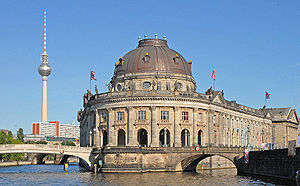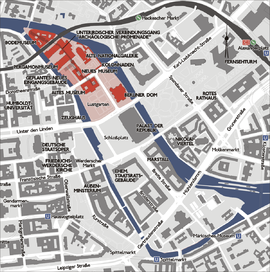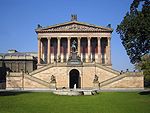- Museum Island
-
Museumsinsel (Museum Island), Berlin * UNESCO World Heritage Site
Country Germany Type Cultural Criteria ii, iv Reference 896 Region ** Europe and North America Inscription history Inscription 1999 (23rd Session) * Name as inscribed on World Heritage List
** Region as classified by UNESCO- For the Museum Island in Munich, see Museum Island (Munich).
Museum Island (German: Museumsinsel) is the name of the northern half of an island in the Spree river in the central Mitte district of Berlin, Germany, the site of the old city of Cölln. It is so called for the complex of five internationally significant museums, all part of the Berlin State Museums, that occupy the island's northern part:
- The Altes Museum (Old Museum) completed on the orders of Karl Friedrich Schinkel in 1830.
- The Neues Museum (New Museum) finished in 1859 according to plans by Friedrich August Stüler, a student of Schinkel. Destroyed in World War II, it was rebuilt under the direction of David Chipperfield for the Egyptian Museum of Berlin and re-opened in 2009.
- The Alte Nationalgalerie (Old National Gallery) completed in 1876, also according to designs by Friedrich August Stüler, to host a collection of 19th century art donated by banker Joachim H. W. Wagener
- The Bode Museum on the island's northern tip, opened in 1904 and then called Kaiser-Friedrich-Museum. It exhibits the sculpture collections and late Antique and Byzantine art.
- The Pergamon Museum, the final museum of the complex, constructed in 1930. It contains multiple reconstructed immense and historically significant buildings such as the Pergamon Altar and the Ishtar Gate of Babylon.
In 1999, the museum complex was added to the UNESCO list of World Heritage Sites.
Contents
History
A first exhibition hall was erected in 1797 at the suggestion of the archaeologist Aloys Hirt. In 1822, Schinkel designed the plans for the Altes Museum to house the royal Antikensammlung, the arrangement of the collection was overseen by Wilhelm von Humboldt. The island, originally a residential area, was dedicated to "art and science" by King Frederick William IV of Prussia in 1841. Further extended under succeeding Prussian kings, the museum's collections of art and archeology were turned into a public foundation after 1918. They are today maintained by the Berlin State Museums branch of the Prussian Cultural Heritage Foundation.
Museum Island further comprises the Lustgarten park and the Berlin Cathedral. Between the Bode and Pergamon Museums it is crossed by the Stadtbahn railway viaduct. The adjacent territory to the south is the site of the former Stadtschloss and the Palace of the Republic.
The Prussian collections became separated during the Cold War during the division of the city, but were reunited after German reunification, except for the art and artefacts removed after World War II by Allied troops and not yet returned; these include the Priam's Treasure, also called the gold of Troy, excavated by Heinrich Schliemann in 1873, then smuggled out of Turkey to Berlin and today kept at the Pushkin Museum in Moscow.
Currently,[when?] the Museumsinsel and the collections are in the process of being reorganized. Several buildings were destroyed in World War II and some of the exhibition space is in the process of being reconstructed.
Museum Island is referenced in the song "On the Museum Island" by folk artist Emmy the Great.
The southern section of the island, south of Gertraudenstraße, is commonly referred to as Fischerinsel (Fisher Island) and is the site of the Fischerinsel high-rise apartment development, built when Mitte was part of East Berlin.
Photogallery
-
Panorama with River Spree
See also
- Berlin State Museums
- List of museums in Berlin
External links
- Official Museum Island website
- Masterplan Museumsinsel Berlin
- Museum Island — Interactive 360° panorama during the Festival of Lights
- A Remarkable Success Story – the Museum Island in Berlin, article on the website of the Goethe-Institut, February 2010


Neighbourhoods of Mitte locality (Mitte district, Berlin)  Alexanderplatz • Alt-Berlin (with Nikolaiviertel) • Cölln (with Fischerinsel and Museumsinsel) • Dorotheenstadt • Friedrichstadt • Friedrichswerder • Friedrich-Wilhelm-Stadt • Luisenstadt • Neukölln am Wasser • Oranienburger Vorstadt • Rosenthaler Vorstadt • Spandauer Vorstadt (with Scheunenviertel) • Stralauer Vorstadt
Alexanderplatz • Alt-Berlin (with Nikolaiviertel) • Cölln (with Fischerinsel and Museumsinsel) • Dorotheenstadt • Friedrichstadt • Friedrichswerder • Friedrich-Wilhelm-Stadt • Luisenstadt • Neukölln am Wasser • Oranienburger Vorstadt • Rosenthaler Vorstadt • Spandauer Vorstadt (with Scheunenviertel) • Stralauer Vorstadt
Coordinates: 52°31′17″N 13°23′44″E / 52.52139°N 13.39556°E
Categories:- World Heritage Sites in Germany
- Museum Island
- Museums in Berlin
- Zones of Berlin
- Mitte
- Landmarks in Germany
- Museum places
- Art gallery places
- Islands of Germany
- Prussian cultural sites
- River islands
Wikimedia Foundation. 2010.






